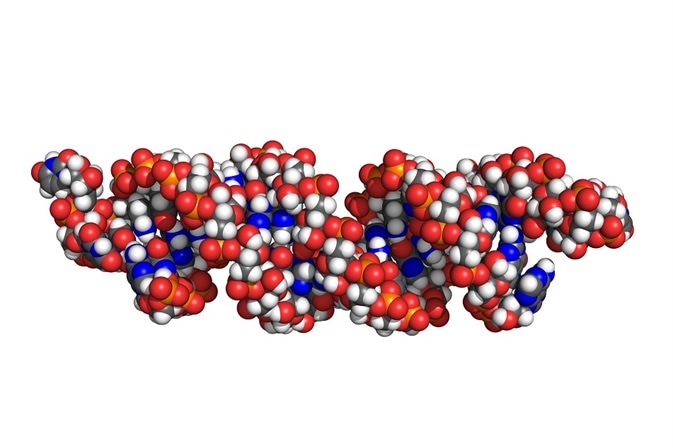RNAi is a powerful tool to used to define cellular mechanisms, and analyze the gene functions of various organisms in laboratories worldwide.
 Credit: petarg/ Shutterstock.com
Credit: petarg/ Shutterstock.com
Fragments of RNA comprising small interfering RNA (siRNA) molecules that block the function of specific genes via a natural process is known as RNA interference (RNAi), which is also called gene silencing.
RNA interference is known to vary in different organisms, varying in the efficiency from high to low, based on the specific organism. Owing to this variation, different RNAis are used in genetic model organisms such as eukaryotes, insects, mammals, and plants to investigate the functions of individual genes.
RNAi in eukaryotes
Double-stranded RNA is determined as an efficient inhibitor for the suppression of a specific sequence of gene expression in eukaryotes, such as C. elegans. RNAi can be achieved in eukaryotes in the following ways:
- Simply soaking the worm in siRNA-containing media
- Directly injecting the dsRNA into the nematode worm
- By feeding the worm bacteria that express siRNAs
RNAi has been found to facilitate both reverse and forward genetics. Two mutants such as eri-1 and rrf-3 were identified using RNAi, which are useful to study the nematode nervous system. This C. elegans worm model is useful as a key tool for studying neural and neurodegenerative disorders. Integration of such genomic tools with an improved and speedy mechanism helps to achieve large-scale projects as a result of the rapid development of RNAi applications.
RNAi in insects
RNAi was first shown in D. melanogaster by inoculation of dsRNA into its embryos. This type of RNAi delivery method has the limitation that RNAi lasts for only a short period in the embryos of flies. This problem is resolved using a stably integrated hairpin dsRNA transgene. By injecting the dsRNA into the abdomen of adult fly, RNAi can be achieved throughout the body.
Further multiple RNAi researches were carried out using Drosophila cell culture and RNAi was accomplished by adding the dsRNA into the cell culture. A RNAi screening method with high throughput was developed using this cell culture to identify genes that relate to cell morphogenesis.
Using widely available methods and protocols, the RNAi living-cell microarray screening method was developed, which was another significant advancement of RNAi. In this method, drosophila cells are directly cultured on the top of the dsRNAs printed on glass microarrays. The microarray RNAi mechanism can be utilized for complete screening of fly genome on three standard glass slides for study of genetic interactions, as two genes can be suppressed at once.
RNAi in mammals
To analyze the gene function in any empirical system, RNAi is used to eliminate expression of the specific genes and observe the resulting effects. This method has gained importance in mammalian systems by the creation of knockout mice models.
Although it is an effective model, it has some problems as follows:
- Developmental or cell-type-specific effects cannot be studied using this model until tissue-specific knockouts are employed;
- Formation of knockout models consumes more time, and requires intense labor.
- However, these problems have the theoretical solution of adapting RNAi techniques.
Both vectors including siRNA and shRNA are injected into adult mice, along with cationic lipid composition, in some cases. For the successful transfer of shRNAs into the brain of adult mice, adenoviral and lentiviral vectors are injected, which readily suppress enhanced green fluorescent protein (eGFP) expression.
In this experimental sequence, RNAi inoculations were performed at the right striatum and eGFP insertions were done in the contralateral hemisphere. Then, the knockdown eGFP was observed for a week, which is also achieved by the insertion of lentiviral shRNA a week later, subsequent to eGFP inoculation.
The knockdown of endogenous genes can also be accomplished by utilizing viral-mediated RNAi. In mid-brain neurons of adult mice, the inoculation of an adenoviral shRNA that targets tyrosine hydroxylase obstructed the synthesis of dopamine and led to reduced progressive working.
RNAi in crop plants
RNAi can be achieved in plants via transgenes, which produce hairpin RNA. RNAi has merits over antisense-mediated gene silencing and co-suppression based on its stability and efficiency, which helps in genetic improvement of crop plants. It has the ability to cut off transgene expression from multigene families in a regulated manner, and it also suggests several advantages over mutation-based reverse genetics.
Outlook
Multiple studies are ongoing on RNA silencing to improve understanding of the RNAi mechanism, and promising its application in the research and treatment field. This mechanism is economical and renders enormous flexibility.
Another invaluable aspect of RNAi is its ability to produce dose-dependent and graded phenotypic outcomes. Neurobiology reaps great benefit from the RNAi method, like other research areas. RNAi has radical genetic toolkits in hand, specifically for researchers of neurobiology involving the rat experimental system.
Sources:
- https://www.ncbi.nlm.nih.gov/projects/genome/rnai/
- https://www.ncbi.nlm.nih.gov/pmc/articles/PMC3249004/
- academic.oup.com/hmg/article-pdf/13/suppl_2/R275/1711235/ddh224.pdf
- https://www.ncbi.nlm.nih.gov/pmc/articles/PMC309050/
- https://www.ncbi.nlm.nih.gov/pmc/articles/PMC1895153/
- https://www.ncbi.nlm.nih.gov/books/NBK2557/
- https://www.ncbi.nlm.nih.gov/pmc/articles/PMC2908776/
- https://entomology.ca.uky.edu/pallilab
- citeseerx.ist.psu.edu/…/download;jsessionid=DA2C53C2EFB9F5CF3B051B6913C5FA60
- https://ncats.nih.gov/rnai/about/action
- https://www.umassmed.edu/rti/biology/how-rnai-works/
- https://www.ncbi.nlm.nih.gov/pubmed/15081052
Further Reading
- All RNAi Content
- RNAi Biological Functions
- Short Hairpin RNA (shRNA) Interference: Therapeutic Applications
Last Updated: Feb 26, 2019
Source: Read Full Article